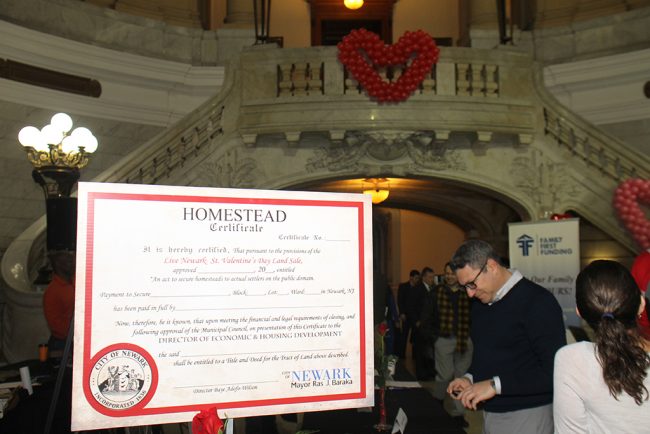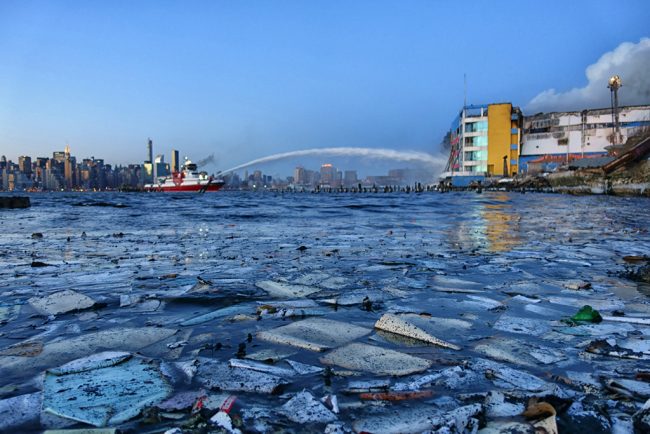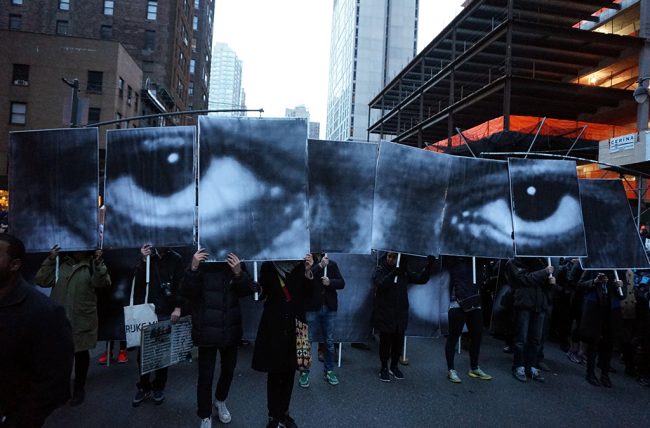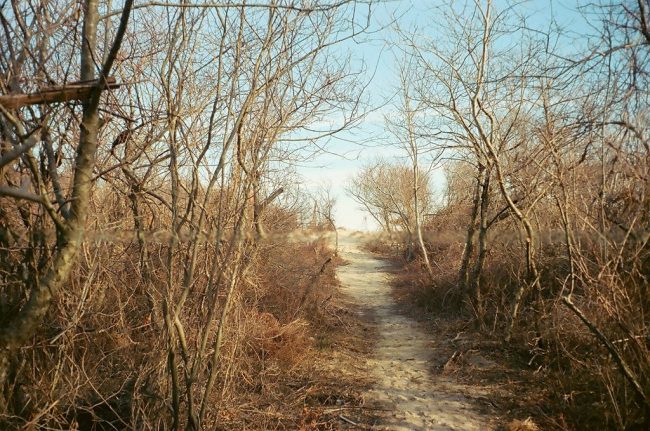
We are celebrating 15 years — and counting — of stories that are deeply researched and deeply felt, that build a historical record of what the city has been.
We are celebrating 15 years — and counting — of stories that are deeply researched and deeply felt, that build a historical record of what the city has been.
Daylight has returned, the spring equinox comes Friday, and the snow has largely melted, leaving behind “mostly generic slime” and a winter’s worth of litter and forgotten curbside deposits. To celebrate the city’s stirring from hibernation, we’ll be at 61 Local in Cobble Hill tonight for OmniBeers, our occasional gathering of Omnibus readers, writers, editors, and general urban enthusiasts over happy hour drinks. There’s no better time to catch you up on some notable news and happenings from around the five boroughs and just beyond — this is your post-thaw roundup.

The Newark Valentine’s Day lot sale | Photo via Newark Press Office
For Sale: Vacant Homes and Vacant Lots
Last month on UO, Elizabeth Rush brought you the story of New York State’s buyouts of three communities on Staten Island post-Sandy and the plan to return those areas to open space. The State is running another buyout program in the city and on Long Island — one that purchases damaged homes in communities where many residents chose to stay put and resells the properties for renovation or redevelopment at prices significantly below pre-storm value. The first batch of 700 State-owned properties on Long Island will be on sale “for a song” at an auction in May, and buyers will have to construct new homes able to withstand stronger storms within three years. Those homeowners who stayed put may get another chance at relief after FEMA announced the unprecedented step of reopening all Sandy-related insurance claims following allegations of insurance companies fraudulently altering engineering reports that resulted in inadequate payouts.
To the west of the five boroughs, in Newark, New Jersey, a Valentine’s Day sale of 100 vacant, City-owned lots for $1,000 each drew a line of prospective homesteaders. Only couples (gay, straight, friends, married, or not) were eligible to purchase the properties, which must be closed upon within three months, support a new home within 18, and lived on by the couple for five years. And while over 500 people flocked to the sale, those that came away with a lot will likely face financing challenges in getting their houses off the ground. Whether such homesteading programs are an effective way to combat urban blight is also unclear; Alan Mallach, senior fellow at the Center for Community Progress and blight expert, says the strategy has “a really mixed track record, and very limited, frankly, examples of success except when it’s really focusing on quite well-to-do families.”
In the five boroughs, where the days of selling vacant land on the cheap are long past, City Planning Commissioner Carl Weisbrod acknowledged that the mayor’s ambitious housing plan would not ultimately solve the city’s housing crisis. For that, Weisbrod echoed recent calls for a more regional approach to housing affordability that would support the vitality of New York City and its surrounding, interdependent communities.

Don’t clog up the water treatment pipes with wet wipes. | Photo via NYC Water
Cleaning Up the Wet Wipes
Wipe down your bathroom if you like, but don’t flush the wipes down the toilet, says the City’s Department of Environmental Protection, which oversees our sewer system and water treatment plants. Wet wipes, many of which are marketed as “flushable,” don’t actually disintegrate like regular toilet paper; instead, “The dank clusters, graying and impenetrable, gain mass like demon snowballs as they travel,” clogging pipes and grinding down equipment. The City says it has spent more than $18 million in the last five years on wipe-related repairs after a dramatic increase in their use.
While lawmakers are moving to have producers remove the “flushable” label from wipe containers, they also questioned DEP Commissioner Emily Lloyd on the agency’s 2015 budget, which is funded almost entirely by water and sewer fees. Some of those fees go toward paying debt service on the City’s water infrastructure projects, but in recent years, the amount “paid” to the City exceeded the amount of that service, causing consternation that fees meant to support better water and sewer service were being siphoned off for unrelated projects, resulting in higher water rates for residents.
Whither Park Promises?
The 2005 rezoning of Williamsburg and Greenpoint that permitted the growth of towers along the formerly industrial East River waterfront is now counted as one of the most transformational, and controversial, land use changes of the Bloomberg era. Part of the rezoning deal was the creation of 30 acres of new parkland for the area, considered one of the most park-starved in the city. But the centerpiece of the plan, Bushwick Inlet Park, is now in jeopardy. Its construction has been halting; a decade after the deal was struck, only three of six needed parcels have been acquired by the City and a small portion built. A key parcel yet to be acquired — a CitiStorage facility on the waterfront that was destroyed by a fire in January — is now rumored to be up for sale. If the property, which went from a $19 million value in 2006 to an asking price of $120 million in 2011, were sold to someone other than the City, park advocates and neighborhood activists say that hopes of fully realizing the park would be all but dead. And as the de Blasio administration aims to encourage affordable housing development through neighborhood rezonings across the five boroughs, failure to follow through on promises from an earlier rezoning could tarnish the City’s word as public meetings on the administration’s plans get under way.

An FDNY boat fights the CitiStorage fire on the Williamsburg waterfront. | Photo via Vladimir Badikov
Someday, Perhaps, a New Bus Terminal
Preliminary results of a Port Authority study on replacing its outdated and overcrowded bus terminal are in, and the estimated cost of a new terminal that meets the city’s growing needs is ten times a figure released last year, ringing in at $10 billion. But the plan, which would take up to 15 years to complete, currently lacks funding, and it faces competition for federal, state, and city dollars from Amtrak’s similarly vital cross-Hudson Gateway rail tunnel. Matching the scale of the financial undertaking, the infrastructural and logistical challenges are huge, as a temporary terminal would need to be constructed nearby while the current structure is demolished and a new one built. Variations on the plan call for the sale of development rights on the current site to make way for skyscrapers that could subsidize the terminal.
Sounds of Buildings, Sounds of Shots
Last January, we talked with architect Karen Van Lengen about her project Soundscape Architecture, an interpretative website that allows you to listen to the sounds of architecture. Van Lengen has now taken the project to the Museum of the City of New York, where the exhibition Soundscape New York combines the sounds of iconic New York interiors, such as Grand Central Terminal and the Seagram Building lobby, with visual projections. Catch it through June 7th uptown.
Van Lengen isn’t the only one listening to the city. The NYPD announced that it would expand a one-year pilot program, ShotSpotter, that uses microphones to detect gunfire and speed up police response. So far, the Bronx and Brooklyn have the technology, though any detected sounds get “verified” for accuracy by a technician in California before making their way to a responding unit. The microphones are part of a much larger network of a surveillance equipment deployed throughout the city. Take a walk through some of their visible manifestations, and those of other network infrastructure in the city, in the guide Seeing Networks.

Protesters at Millions March NYC in December | Photo via The All-Nite Images
Black Lives and Architecture
Aggregate, a website hosted by the Aggregate Architectural History Collaborative, supports the production, peer review, publication, and discussion of innovative research in architectural history and theory. That may sound dry to some, but their latest project, Black Lives Matter, is anything but. Composed of several short essays precipitated by renewed activism in response to the killing of black Americans by police officers, the collection asks provocative questions well worth exploring: “What does it mean to put black lives at the center of our thinking about architecture and its history; how do architecture and urban design contribute to violence against black people; and how can the tools and knowledge of our disciplines prompt change?”

A dune at Fort Tilden | Photo via Bastian T.
STUFF TO DO
Planning for Beach Time
Don’t get greedy and skip past spring, but the National Park Service has opened comments for its planning process of post-Sandy repairs and updates at Fort Tilden on the Rockaways. Weigh in on resiliency measures and how your beach experience could be better!
Atlases Against Empire: A Women Measures the City
On April 2nd, celebrated writer, historian, and activist Rebecca Solnit will deliver the eleventh annual Lewis Mumford Lecture on Urbanism in City College’s Great Hall. For a peek at what’s to come, read a recap of Solnit’s address at The Architectural League’s 5KL: Land symposium.
Housing — What’s Really Possible?
There’s no dearth of discussion on housing these days, but amid ambitious construction goals and subsidy program debates, the Institute for Public Architecture and the Pratt Institute School of Architecture are convening architects, historians, urban advocates, and city officials to present case studies of approaches that bore fruit. Slip out for the morning of Friday, April 10th, for the free symposium “An Inventory of What’s Possible.”
The Roundup keeps you up to date with topics we’ve featured and other things we think are worth knowing about. Formerly a weekly tradition published every Friday, we now bring you the roundup on an occasional basis.
The views expressed here are those of the authors only and do not reflect the position of The Architectural League of New York.
Comments